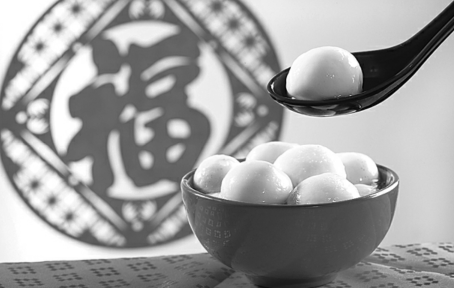With the first full moon of the lunar year, the 15 days of celebrations for Spring Festival wind down, and life will return to normal. On this day, yuanxiaojie, or Lantern Festival, there will be one final round of eating and drinking.
Symbolism is very important in Chinese culinary traditions, and so, to reflect the full moon, glutinous dumpling balls will be eaten first thing in the morning. Tangyuan and yuanxiao will be made and eaten throughout the country.
Tangyuan is popular in southern China and is made by mixing fine glutinous rice powder with water to form a dough, which is then molded around fillings like red bean paste, sesame paste and crushed peanuts. They are cooked in sweet soups, sometimes scented with osmanthus flowers or flavored with sweet rice wine.
Yuanxiao, named after the day itself, is a northern delicacy. Its production is more complex and involves a ball of filling tossed onto damp glutinous flour on a tray. The tray is rhythmically rolled around until the filling is coated with layers of rice flour, and become nice and round. These dumplings are then cooked in water.
 |
|
Tangyuan is a glutinous rice ball stuffed with varying flavors of paste filling.[Photo provided to China Daily] |
Both are sticky dumplings with round shapes that denote tuanyuan, or reunion. For many families, its members would once again depart from home with the sweet taste of the dumplings in their mouths and memories as they return to the cities to work.
It may be a full year again before they get the chance to see home and hearth.
But, before they go, there is still one more day to relax.
In many parts of the country, yuanxiaojie is marked with lantern parades and exhibitions. Intricately made lanterns of all shapes, sizes and colors are gathered in parks and town squares and brightly lit.
Everyone competes to see who comes up with the prettiest, tallest, biggest, longest lanterns.
Often, these have poems on them that are riddles and groups of friends will make the rounds to see who is best at solving the word puzzles.
Culture parades featuring folk dances, stilt walkers, costumed opera characters, choirs and modern day singers and dancers add to the final festive air. This is also the last day of Lunar New Year temple fairs, a traditional fairground for holiday makers.
On this day, lion and dragon dancers will be doing their best to impress their audiences, ending a fortnight of performances which have earned them considerable amounts of lucky money in red packets or hongbao.
It is also around this period that the various clan or village associations will have competitions among them to find the most able lion or dragon dance teams. These can get pretty intense in the heat of fire crackers, loud drums and arty martial arts moves.
When it comes time to eat, all the auspicious dishes that marked the first new year meals return to the table, including the festive chickens, pig trotters, whole fishes and vegetarian specials.
In addition, jiaozi, or dumplings and noodles are also served. It is a northern tradition to have jiaozi on all major occasions, and a farewell meal definitely needs jiaozi.
Noodles, for good health and longevity will also be on the table. Different communities will serve their regional specialties from light soup noodles to rich braised noodles topped with seafood and meat.
Once the evening meal is finished, many will opt for an early night to prepare for their long journeys the next day. Life goes back to normal.

Presented by Chinadaily.com.cn Registration Number: 10023870-7
Copyright © Ministry of Culture, P.R.China. All rights reserved